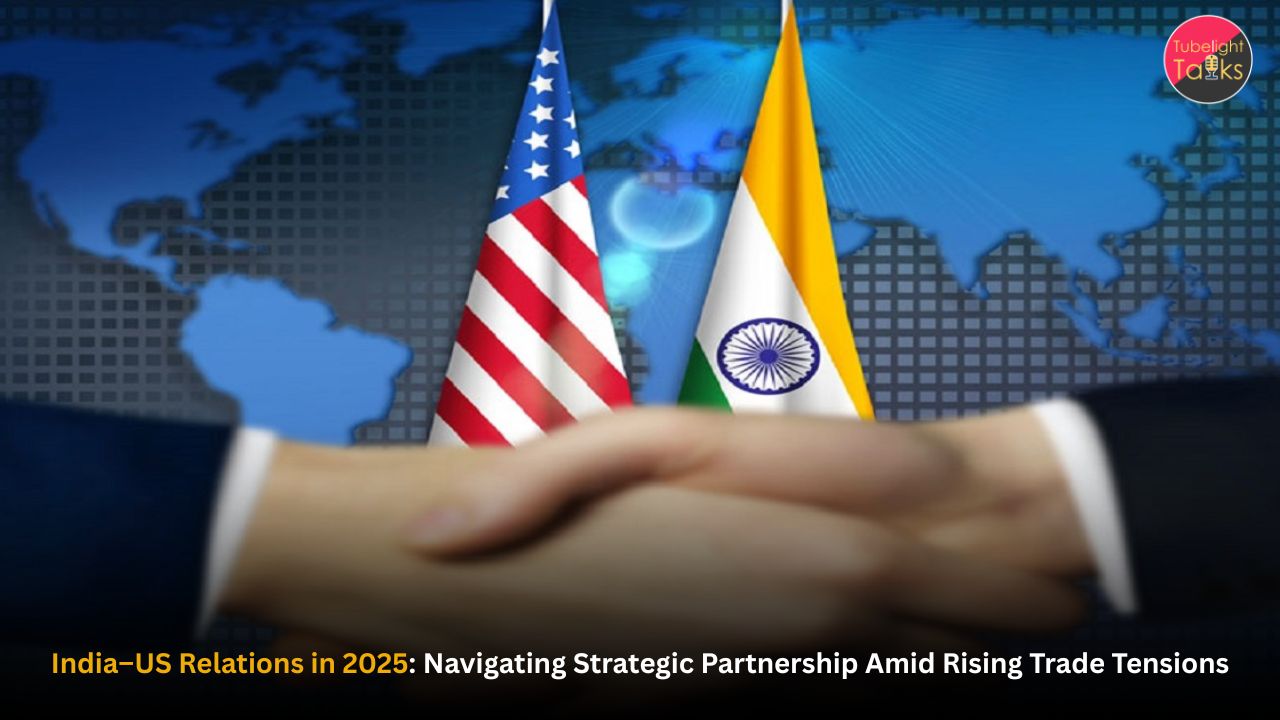New Delhi, August 11, 2025 — The relationship between India and the United States is widely regarded as one of the most significant global partnerships of this century. Spanning a vast spectrum from defence collaboration and cutting-edge technology cooperation to complex trade negotiations, this multifaceted alliance has been evolving dynamically. However, recent escalations in trade tensions have cast a shadow over an otherwise robust strategic partnership — raising questions about how two democracies with shared values will balance their economic differences while advancing common geopolitical goals.
A Foundation Built on Shared Strategic Interests
The India–US relationship is not new, but its rapid acceleration since the early 2000s has transformed it into a comprehensive global partnership. Landmark agreements on civil nuclear cooperation, defence logistics, and counterterrorism cooperation have laid the groundwork for strategic trust.
India’s emergence as a regional power in the Indo-Pacific and the mutual concern over China’s growing assertiveness have further deepened the bond between New Delhi and Washington. The two countries view each other as critical partners in maintaining a free and open Indo-Pacific — an increasingly contested geopolitical theatre.
In addition to formal diplomatic efforts, the relationship flourishes due to dynamic connections between individuals. The Indian diaspora in the United States, now one of the largest and most influential immigrant groups, plays a crucial role in bridging cultural and economic exchanges. Joint military exercises like “Yudh Abhyas” and “Vajra Prahar” have become annual fixtures, symbolizing deepening defence interoperability.
Technological collaboration also forms a cornerstone, with bilateral space missions and intelligence sharing steadily expanding.
Rising Trade Frictions: The New Challenge
Despite these positive strides, the economic relationship has recently hit a snag. Last week, the US administration announced a sharp increase in tariffs on a range of Indian exports, some reaching as high as 50%. The affected sectors include textiles, engineering goods, and agricultural products — all vital pillars of India’s export economy.
The US government linked this tariff hike primarily to India’s continued purchase of discounted Russian oil, a move Washington views as undermining the global sanctions regime against Russia following its actions in Ukraine. India, on the other hand, maintains that securing affordable energy is essential to managing inflation and ensuring economic stability for its vast population.
Also Read: Yamuna River Nears Warning Level at 204.14 Metres in Delhi | Flood Alert
This trade friction exposes the complexities of a relationship where geopolitical considerations intersect with economic realities. Indian exporters and industry bodies have voiced concerns about potential job losses and reduced competitiveness if these duties remain in place. Small and medium enterprises, in particular, fear losing their foothold in the lucrative American market.
Strategic and Technological Collaboration: A Story of Success
While the trade dispute attracts headlines, the strategic and technological dimensions of the India–US partnership continue to flourish. India recently became the largest supplier of smartphones to the US market, a landmark achievement that highlights India’s growing role as a manufacturing hub.
In semiconductor manufacturing, US companies are investing heavily in Indian facilities to diversify supply chains that have been disrupted by recent global events. This cooperation is not only commercial but also strategic, aimed at reducing dependence on any single country for critical technology components.
Defence collaboration is expanding with joint projects on advanced aircraft engines and maritime surveillance systems. These projects underscore the shared interest in safeguarding regional security and enhancing military readiness. The two countries are also pushing forward with space exploration initiatives, including preparations for joint lunar missions, symbolizing a forward-looking partnership in science and innovation.
Expert Insights: Navigating a Complex Partnership
Analysts characterize the present stage of the India–US relationship as a reflection of the partnership’s maturity. A seasoned foreign policy expert based in New Delhi comments:
“The US and India are too strategically important to allow a trade dispute to undermine the broader cooperation. While the economic disagreements are significant, there is strong political will on both sides to prevent these issues from spilling into the political or security domains.”
Some experts see the tariff issue not only as a challenge but also as an opportunity. The dispute could catalyze deeper trade negotiations aimed at creating a more balanced and transparent framework for bilateral commerce. These talks might pave the way for resolving long-standing trade irritants and expanding market access.
The Road Ahead: Balancing Cooperation and Competition
High-level talks between Indian and US trade representatives are anticipated in the coming months. Both sides appear eager to find common ground — possibly through phased tariff reductions paired with commitments to open specific sectors more fully to bilateral trade.
Meanwhile, defence and technology cooperation is expected to continue unfazed by economic disagreements. With shared concerns about regional threats and the necessity of building resilient supply chains, these areas of cooperation remain a priority.
Looking forward, experts highlight emerging domains for partnership expansion, including clean energy, digital infrastructure, and advanced manufacturing. Both countries recognize the potential of these sectors to drive future economic growth and bolster their strategic alliance.
Conclusion: A Relationship Tested but Unbroken
The India–US relationship in 2025 stands at a critical crossroads. On one hand, strategic ties have never been stronger, reflecting shared values and mutual security interests. On the other hand, economic disputes serve as a reminder that even the closest of allies must continuously manage their differences.
The coming months will be crucial. How the two countries navigate this moment of friction will not only determine the immediate future of their trade relationship but also set the tone for deeper cooperation in other vital areas.
If diplomacy prevails and economic disputes are resolved without eroding trust, the India–US partnership will likely emerge even stronger — a model for how democracies can balance strategic necessity with economic interests in a rapidly shifting global order.










